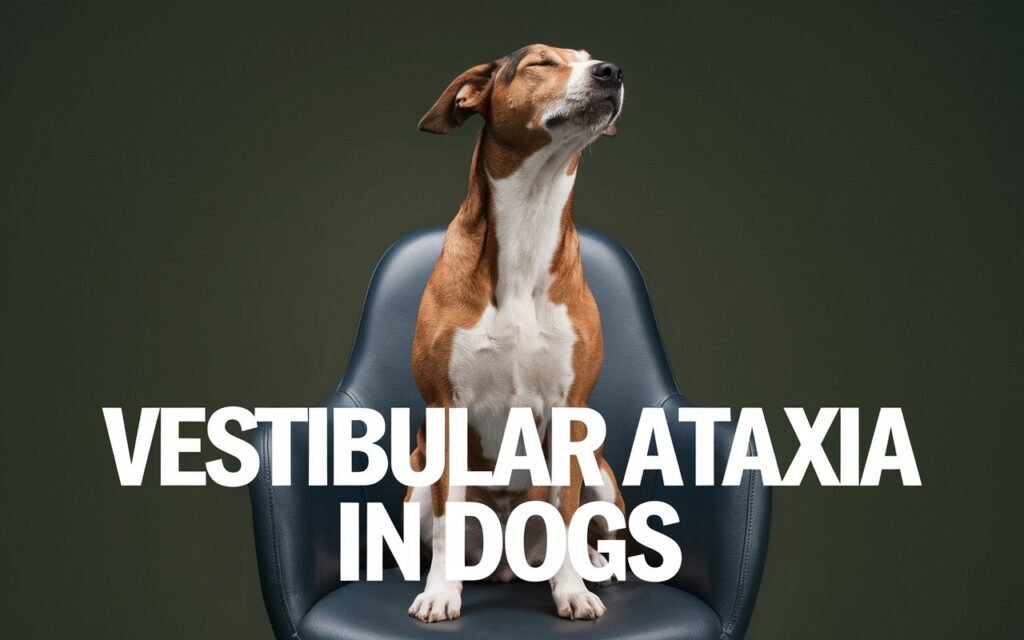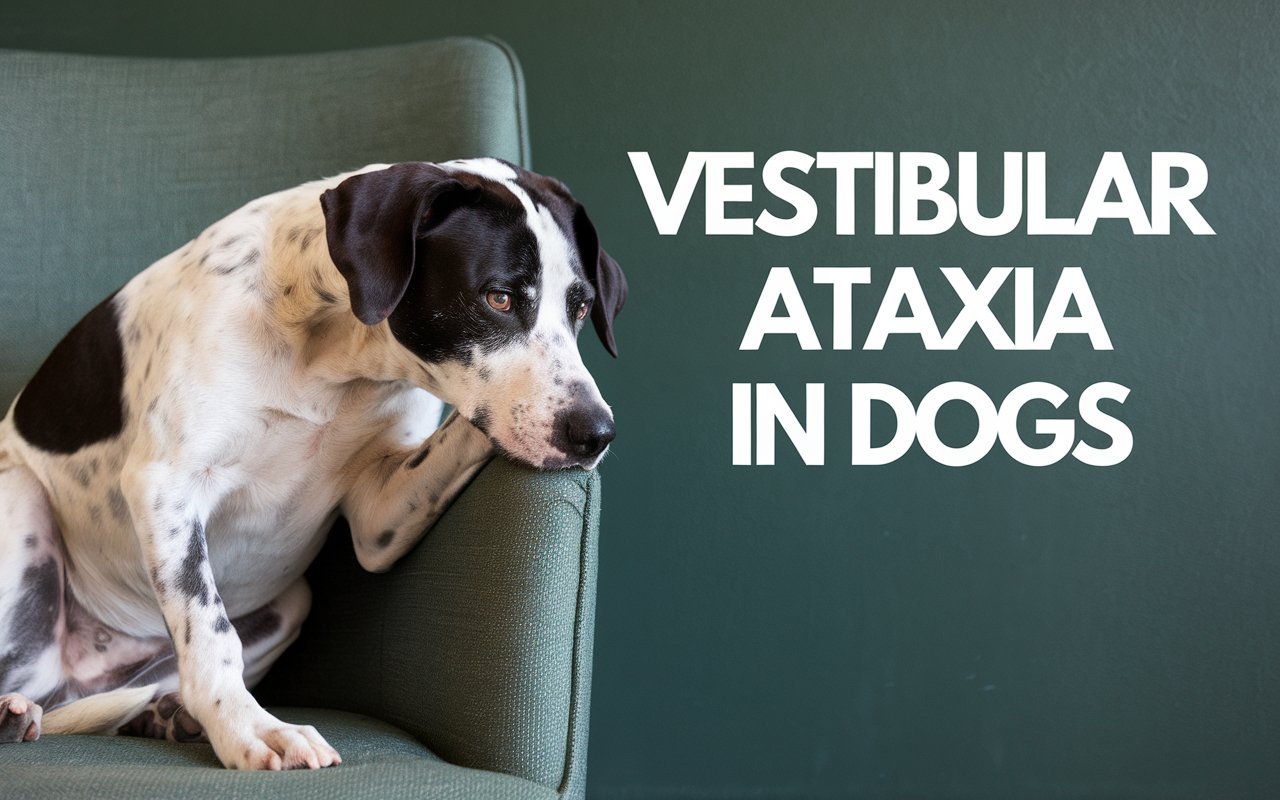Vestibular ataxia in dogs is a disorder. It disrupts balance and coordination. Affected dogs appear dizzy or unsteady. This condition stems from issues in the vestibular system, a complex network that governs equilibrium. Dog owners must spot the signs early. Quick action can prevent problems and help your pet. This guide covers all aspects of vestibular ataxia in dogs. It explores its causes, symptoms, and treatments.
Table of Contents
Understanding Vestibular Ataxia in Dogs
Components of the Vestibular System
The vestibular system includes the inner ear, vestibular nerve, and parts of the brain, such as the brainstem and cerebellum. These components interact seamlessly to monitor a dog’s spatial orientation. The inner ear has structures like the semicircular canals. They detect rotation. The otolith organs sense linear motion and gravity.
How the Vestibular System Works
When a dog moves its head, the inner ear transmits signals to the brain about the change in position. This information allows the brain to adjust the dog’s posture and maintain balance. A disruption in this intricate system causes vestibular ataxia. It leads to symptoms like stumbling and head tilting. Understanding this mechanism underscores the complexity of diagnosing and treating the condition.

Causes of Vestibular Ataxia in Dogs
Idiopathic Vestibular Disease
One of the most common causes of vestibular ataxia in dogs, especially in older dogs, is idiopathic vestibular disease. This condition occurs when the vestibular system, which controls balance, stops working for no known reason. Often, this condition improves with time, but it can cause symptoms such as disorientation, head tilt, and loss of balance. The exact cause of idiopathic vestibular disease is unknown, though it’s believed to be related to aging.
Ear Infections
Ear infections, particularly those affecting the inner ear, can lead to vestibular ataxia in dogs. The inner ear helps with balance. Infections like otitis media or otitis interna can cause inflammation or fluid buildup. This can lead to dizziness and imbalance. These infections are often treatable with antibiotics or antifungals, depending on the cause.
Neurological Disorders
Vestibular ataxia can also result from neurological issues affecting the brain or spinal cord. Brain tumors, strokes, and encephalitis can disrupt the vestibular system. They can cause balance problems. These conditions often need specialized treatment or surgery. They may have a more complicated prognosis.
Trauma or Injury
Head trauma or injuries, such as those from accidents or falls, can damage the brain or inner ear, resulting in vestibular ataxia. Recovery may require medical treatment, rest, and therapy. It depends on the injury’s severity.
Toxins or Medications
Certain toxins or medications can affect the vestibular system and lead to balance issues. For example, some pesticides and some drugs can cause vestibular symptoms. These drugs include antibiotics and anti-seizure meds. Identifying and removing the toxin or adjusting the medication can help resolve these symptoms.
Symptoms of Vestibular Ataxia in Dogs
Loss of Balance and Coordination
One of the hallmark symptoms of vestibular ataxia in dogs is a sudden loss of balance. Affected dogs may appear disoriented, have difficulty walking, and may stagger or lean to one side. They might also exhibit a head tilt, where their head is consistently turned in one direction, even when standing still.
Nausea and Vomiting
Dogs with vestibular ataxia often experience nausea due to dizziness and disorientation. This can lead to vomiting, particularly after attempts to move or eat. In some cases, dogs may be unable to eat or drink because of their lack of coordination and nausea.
Circling and Spinning
Dogs may circle, often turning one way. This can be due to inner ear issues or neurological problems that affect their balance. This symptom is particularly common in dogs with more severe vestibular problems.
Eye Movements (Nystagmus)
In some cases, dogs with vestibular ataxia will display abnormal eye movements, known as nystagmus. This includes rapid, involuntary eye twitching, often in a horizontal or vertical direction. Nystagmus is typically a sign of a vestibular issue affecting the brain or inner ear.
Disorientation and Behavioral Changes
Dogs with vestibular ataxia may show signs of confusion or disorientation. They might have trouble navigating familiar environments or appear more anxious or fearful. Behavioral changes, such as increased vocalization, may also occur as a result of their discomfort or distress.
Head Tilt
A head tilt, which occurs when the dog holds their head at an abnormal angle, is one of the most recognizable symptoms of vestibular ataxia. This symptom often indicates a vestibular system problem. It may be due to ear issues or neurological causes.
Diagnosis of Vestibular Ataxia in Dogs
Veterinary Examination
The first step in diagnosing vestibular ataxia in dogs is a thorough veterinary examination. The vet will assess the dog’s clinical signs, such as head tilt, balance issues, and eye movements (nystagmus). They will also review the dog’s medical history, including any recent injuries, illnesses, or exposure to toxins. A full physical and neurological exam helps to find the cause of the symptoms. It will determine if they are related to the vestibular system or due to another condition.
Ear Examination and Tests
Since vestibular ataxia is often linked to ear infections or problems within the inner ear, a thorough ear examination is crucial. The vet may use an otoscope to check the ear canal for signs of infection, inflammation, or foreign bodies. If an ear infection is suspected, the vet may take swabs from the ear to identify bacteria, yeast, or parasites causing the issue. Diagnostic imaging, such as an ear canal X-ray or CT scan, might be recommended to rule out underlying ear problems.
Blood Tests
Blood tests may check for infections, metabolic disorders, or systemic illnesses. These could be causing the vestibular ataxia. These tests help rule out conditions that can mimic vestibular ataxia. They include thyroid imbalances, liver disease, and toxins.
Advanced Imaging (MRI/CT Scan)
If the vestibular ataxia may be due to neurological issues, such as brain tumors or strokes, advanced imaging may be recommended. This includes an MRI or CT scan. These scans provide detailed images of the brain and spinal cord. They help the vet find any structural problems affecting the vestibular system.
Other Diagnostic Tests
If a specific cause is suspected, more tests may be done. For example, a CSF analysis may be done if encephalitis or other neurological conditions are suspected. In some cases, genetic testing may also be performed to rule out inherited disorders that can affect the vestibular system.

Treatment Options for Vestibular Ataxia in Dogs
Medications and Supportive Care
Treatment for vestibular ataxia in dogs depends on the underlying cause of the condition. For “old dog vestibular disease,” no treatment may be needed. Symptoms often improve on their own within a couple of weeks. Supportive care can help. This includes medications to reduce nausea, dizziness, or inflammation. If your vet finds an ear infection, they may prescribe drugs. These could be anti-nausea meds, anti-inflammatories, or antibiotics.
Surgical or Specialized Interventions
In complex cases, like tumors or brain injuries, surgery or specialized treatments may be needed. They can cause vestibular ataxia. If an underlying condition causes the vestibular issue, it may need surgery, radiation, or other treatments to fix it. This includes ear infections or brain disorders. In these situations, prompt and targeted treatment is critical for the best possible outcome.
Physical Therapy and Rehabilitation
If balance issues persist, physical therapy may help. It can improve coordination and mobility. Techniques like balance exercises, walking aids, and hydrotherapy can help. They can rebuild your dog’s strength and stability. This will improve your dog’s quality of life during recovery.
Managing Vestibular Ataxia in Dogs at Home
Creating a Safe Environment
Once your dog is diagnosed with vestibular ataxia, the first priority is ensuring their safety at home. To prevent injury during imbalance, remove sharp-edged furniture. Also, put non-slip rugs on slippery floors. You may also want to confine your dog to a secure, low-risk area where they can move around safely, reducing the chances of falls. This is especially important for dogs that may experience dizziness or difficulty walking.
Long-term Care Tips
For dogs with recurring or chronic vestibular ataxia, establishing a consistent routine is key. A regular feeding schedule and gentle, low-impact exercise will keep your dog healthy without overdoing it. Creating a stress-free environment is equally important, as anxiety can trigger flare-ups. Regular grooming, including ear care, is essential to avoid infections, as these can exacerbate the condition. Keeping the area clean will help your dog’s health. Check for signs of discomfort or infection.
Prognosis and Recovery
Recovery Timeline
The recovery timeline for dogs with vestibular ataxia varies based on the underlying cause and severity of the condition. In cases of idiopathic vestibular disease, many dogs show significant improvement within one to two weeks. However, for complex forms like central vestibular ataxia, recovery can take several months. Early diagnosis and treatment are vital for a good prognosis. They can lessen the intensity and length of symptoms.
Factors Affecting Prognosis
Several factors influence the recovery of a dog with vestibular ataxia. Younger, healthier dogs with peripheral causes tend to recover better. They recover faster and more completely. In contrast, older dogs or those with central vestibular ataxia—often from brainstem problems or tumors—may recover slowly or not at all. Your dog’s outcome depends on its health, other conditions, and treatment speed. Regular veterinary monitoring and follow-up care are crucial for managing long-term recovery.

Preventing Vestibular Ataxia in Dogs
Routine Check-ups
Regular vet visits are vital. They help catch and prevent issues that can cause vestibular ataxia, like ear infections or nerve problems. Routine exams let your vet monitor your dog’s health. They can spot problems before they get worse. Early intervention is key. It helps maintain your dog’s vestibular health and prevents balance issues.
Preventive Care Tips
Preventing vestibular ataxia means keeping ears clean and avoiding head injuries. Clean, dry ears prevent infections that could cause vestibular problems. Additionally, using secure collars or harnesses that avoid pressure on the neck and head can reduce the risk of injury. Supervise your dog during playtime. This can prevent accidents or falls that may cause head trauma. Use these tips to prevent vestibular ataxia. They will also boost your dog’s health.
When to Seek Immediate Veterinary Care
Warning Signs
If your dog has sudden, severe symptoms, get veterinary care now. Watch for repeated falling, extreme disorientation, or a lack of coordination. Also, note if it can’t eat or drink. These signs may indicate a serious issue. It could be a neurological disorder or a severe ear infection. Both need urgent treatment. The faster you act, the better the chances for effective management and recovery.
Emergency Steps
While preparing to take your dog to the vet, it’s important to keep them calm and supported. Use a soft blanket or cushion to stabilize their position and prevent further injury during transport. Avoid making any sudden movements, as this could worsen their discomfort or cause additional strain. Keeping your dog as comfortable and stable as possible will help reduce stress until they receive the appropriate care.
Conclusion
Vestibular ataxia in dogs, while alarming, is often manageable with prompt diagnosis and care. Knowing its causes and symptoms helps dog owners act quickly. This ensures effective treatment, whether with medications, supportive care, or surgery. Many dogs recover well. A safe environment, regular check-ups, and ear hygiene help. Although some cases may take time, patience and dedication can restore your dog’s quality of life. Stay informed and proactive. You can help your furry friend. They can overcome this challenge and be happy again.






